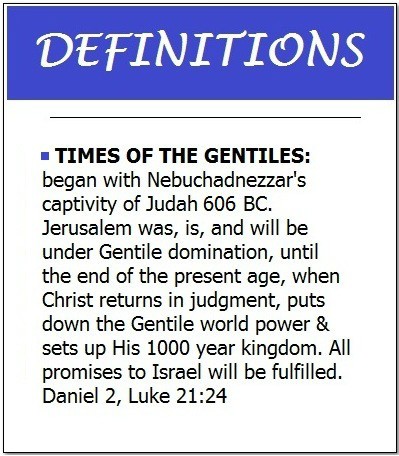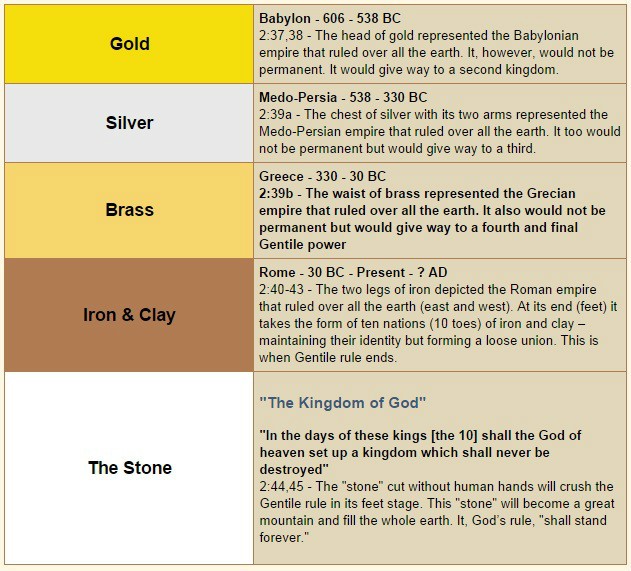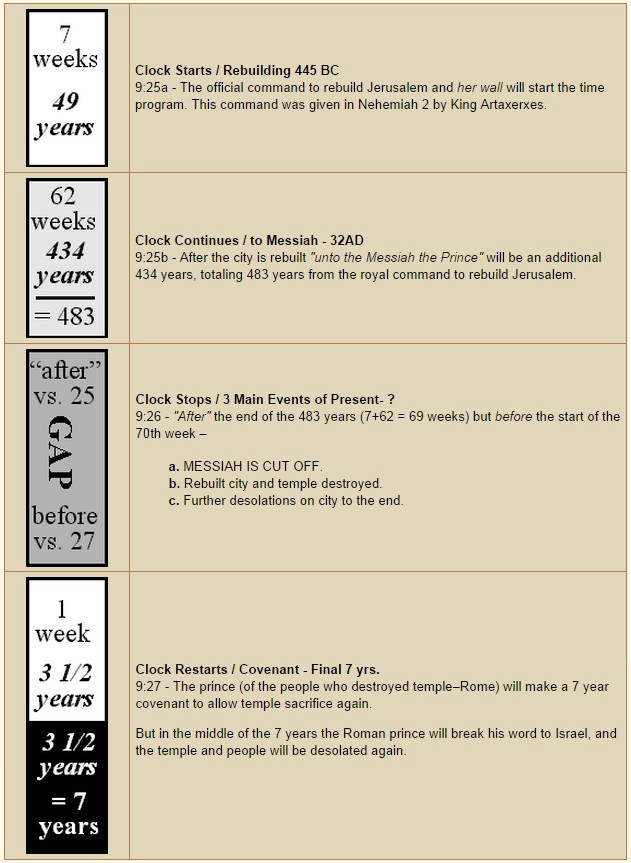 AC Gaebelein on Daniel 2 Read Daniel 2 in your bible. AC Gaebelein on Daniel 2 Read Daniel 2 in your bible.
Nebuchadnezzar's Dream and Its Interpretation
1. The forgotten dream (2:1-13)
2. The prayer meeting in Babylon and the answer (2:14-23)
3. Daniel before the king (2:24-28)
4. The revelation and interpretation of the dream (2:29-45)
5. The promotion of Daniel and his companions (2:46-49)
Verses 1-13
The king had a dream which was occasioned by thinking concerning the future (verse 29). God answered his desire by this dream, which made a great impression on him. But he had forgotten the dream. The soothsayers, wise men and magicians, who were kept by him to interpret dreams, were unable to reveal the forgotten dream: they confessed their utter helplessness. The king condemned them to death. Inasmuch as Daniel and his companions were counted among the wise men, "they sought Daniel and his companions to be slain."
Verses 14-23
And now Daniel steps to the front. But there is no haste and no hurry connected with it, for "He that believeth shall not make haste." He is brought before the king and promises to the king the meaning of that dream. It was the language of faith; he had confidence in God. He knew that the same Jehovah who had given another captive wisdom, Joseph in Egypt, was his God also. Then there was a prayer meeting in Babylon. While the condemned wise men, the astrologers and magicians trembled for fear of death, Daniel and his companions asked "mercies of the God of heaven concerning this secret." The prayer was speedily answered.
Verses 24-28
After Daniel had praised the God of heaven he requested an audience with the king. How beautiful he is in the presence of the mighty monarch! What an opportunity to glorify himself. But he hides himself completely and gives God all the glory. Then he tells the king that in the dream he is about to relate God has made known unto him "what shall be in the latter days."
Verses 29-45
Daniel then told to the king the forgotten dream:
Thou, O King, sawest, and behold a great image. This great image, whose brightness was excellent, stood before thee; and the form thereof was terrible. This image's head was of fine gold, his breast and his arms of silver, his belly and his thighs of brass, his legs of iron, his feet part of iron and part of clay. Thou sawest till that a stone was cut out without hands, which smote the image upon his feet that were of iron and clay, and brake them to pieces. Then was the iron, the clay, the brass, the silver and the gold broken to pieces together, and became like the chaff of the summer threshing-floors; and the wind carried them away, that no place was found for them; and the stone that smote the image became a great mountain, and filled the whole earth (verses 31-35).
The great man image is the prophetic symbol of the "times of the Gentiles." This expression "The times of the Gentiles" is not found in the book of Daniel, but it is a New Testament phrase. Our Lord used it exclusively. In that part of His prophetic discourse which is reported in the Gospel of Luke and which relates to the fall of Jerusalem and the dispersion of the nation, our Lord said: "And they shall fall by the edge of the sword, and shall be led away captive into all nations; and Jerusalem shall be trodden down of the Gentiles until the times of the Gentiles shall be fulfilled" (Luke 21:24). Now, the times of the Gentiles did not begin when Jerusalem rejected the Lord from heaven. Our Lord does not say that the times of the Gentiles were then ushered in. The times of the Gentiles started with the Babylonian captivity by Nebuchadnezzar. The glory of the Lord departed from Jerusalem. The other great prophet of the captivity, Ezekiel, beheld the departure of the Shekinah. "Then did the Cherubim lift up their Wings, and the wheels beside them; and the glory of the God of Israel was over them above. And the glory of the Lord went up from the midst of the city, and stood upon the mountain which is on the east side of the city" (Ezek. 11:22-23). But before that Jeremiah recorded a remarkable word. These are the words of Jehovah concerning Nebuchadnezzar:
I have made the earth, the man and the beast that are upon the ground, by My great power and by My outstretched arm, and have given it unto whom it seemed meet unto Me. And now have I given all these lands into the hands of Nebuchadnezzar the king of Babylon, My servant; and the beasts of the field have I given him also to serve him. And all nations shall serve him, and his son, and his son's son, until the very time of his land come: and then many nations and great kings shall serve themselves of him. And it shall come to pass, that the nation and kingdom which will not serve the same Nebuchadnezzar the king of Babylon, and that will not put their neck under the yoke of the king of Babylon, that nation will I punish, saith the Lord, with the sword, and with the famine, and with the pestilence, until I have consumed them by his hand (Jeremiah 27:5-8).
Jerusalem had been supreme because the throne and the glory of Jehovah was there. Though Assyria, Egypt and Babylon had tried repeatedly to overthrow Jerusalem, they were held in check by the power of God and divine intervention, but when the measure of the wickedness of Jerusalem was full, Nebuchadnezzar was chosen to become the first great monarch of the times of the Gentiles. The dominion was then taken away from Jerusalem and transferred to the Gentiles. Therefore the golden head in this prophetic man-image represents Nebuchadnezzar and the Babylonian empire. The chest of silver, according to divine interpretation, stands for an inferior monarchy which was to follow the Babylonian empire. This second world empire is the Medo- Persian. The belly and thighs of brass represent the third great monarchy, the Graeco-Macedonian. The fourth great monarchy which was to rise during the times of the Gentiles, represented by the two legs of iron, is the iron empire, Rome. Here, then, is history pre-written. God, who knows the end from the beginning, revealed in this dream the course of the times of the Gentiles, beginning with the Babylonian monarchy and followed by three more: The Medo-Persian, the Graeco-Macedonian and the Roman. Notice the process of deterioration as indicated in the composition of this image: Gold, silver, brass, iron, and finally the iron getting less and clay taking a prominent place. It shows that politically the times of the Gentiles are not improving.
Everything which this image represents has been fulfilled, except the last portion, when a stone falls out of heaven and strikes the ten toes and the clay, so that the whole colossal figure goes to pieces, the different constituent metals become like the chaff on the summer threshingfloor and the striking stone becomes a mountain and fills the whole earth. The fourth Empire, the Roman, has not yet fulfilled its history. The final form, and with it the final form of the times of the Gentiles is yet to pass into history. This final form is symbolically seen in the ten toes and the clay, in the feet of the image. The territory which constituted the now extinct Roman empire will in the near future undergo a political revival. It will reappear in a confederated Europe, except certain countries which never belonged to the Roman empire. In that confederacy will be kingdoms to the number of ten; the clay represents democracies, the rule by the people and for the people. The late great war has brought such a political combination into our times. Such is the future and end of the times of the Gentiles, as foretold in the feet of the image. But what does the smiting stone represent, the stone which abolisheth the image and becomes itself a great mountain filling the whole earth? The Stone is Christ. That the stone represents Christ is seen from the Scriptures. "Behold, I lay in Zion for a foundation a stone, a tried stone, a precious cornerstone, a sure foundation" (Isa. 28:16). Zechariah speaks of this stone with seven eyes upon it and engraven.
We read of Him in the New Testament as the foundation stone of the church, the cornerstone, the stone rejected by the builders. Most interesting is His own word in the Gospel of Matthew: "And whosoever shall fall on this stone shall be broken: but on whomsoever it shall fall, it will grind him to powder" (Matt. 21:44). Here we have Israel's sin and judgment and the fate of the Gentiles. Israel stumbled against this stone; for them He was a stumblingstone and rock of offense. In consequence they were broken as a nation. But the Gentile world, rejecting Him, will be broken when the stone falls. They will be ground to powder by the falling stone. Our Lord must have had the dream of Nebuchadnezzar in mind when he spake these words. The falling stone of which He speaks and the striking stone in the dream mean the same Person, Himself The stone doing its work in smiting the image is a prophecy of the second coming of our Lord. The mountain filling after that the earth foreshadows that kingdom which will be established with the return of Christ and His enthronement as King of kings. Verses 46-49. The heathen monarch then acknowledged Daniel's God in a threefold way: The God of Gods (the Father); the Lord of Kings (God the Son); the Revealer of Secrets (God the Holy Spirit). Daniel is lifted from the place of humiliation to a place of exaltation. He did not forget his companions; they share honor and glory with him. It is a beautiful picture of that day when our Lord will receive the throne and when His own will not be left behind in sharing with Him His glory.

 These two charts are from www.thinking7.org These two charts are from www.thinking7.org
Listen to S.Lewis Johnson on this topic at: http://voicesforchrist.org/welcome/search?q=lewis+johnson+history+daniel
|